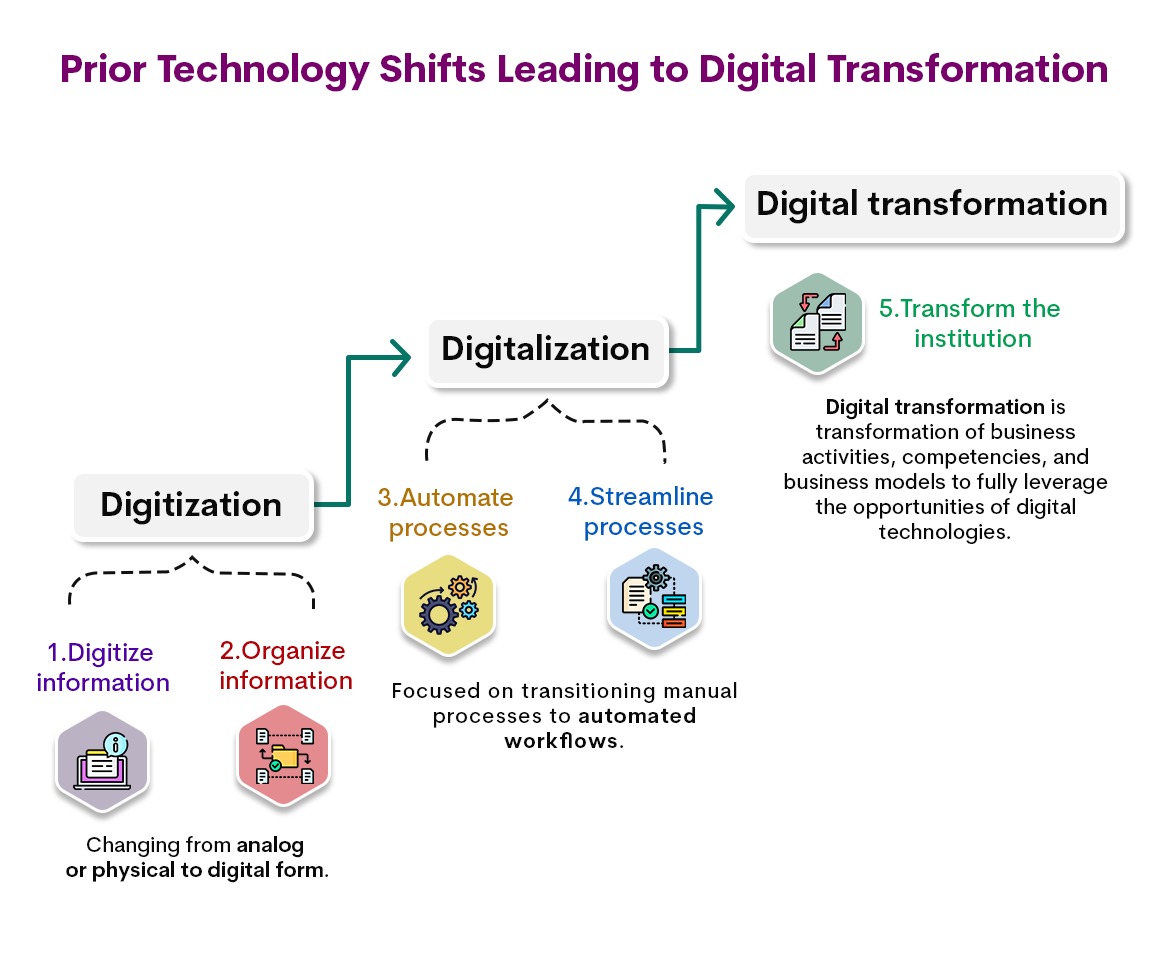
Digital transformation is rethinking technology to suit the needs of today. Both business imperatives and customer expectations have changed today, compared to 5 years ago. Many companies have been digitally transforming their business process but there is always more to be done. While others might have made tentative forays or made none at all. Businesses, whether big or small, should be looking at how to make digital transformation work for their specific business because the possibilities are many
How has digital transformation meaning changed over the years?
One of the earliest references to the term “digital transformation” can be traced back to the late 1990s and early 2000s. Digital transformation meaning back then referred to describing the process of businesses transitioning from paper-based systems to digital technologies. This was a revolutionary move because till then everything was recorded on paper, which meant large physical file documenting systems. However, this usage focused primarily on moving processes online, albeit in a simpler manner than today. It did not include broader organizational and cultural changes that are now associated with digital transformation.
The nuances of “Digital Transformation” as we know it today began to emerge in the mid-2010s. From this period, digital innovation became more pervasive and integral to almost every aspect of both business and society. This usage encompasses a broader set of changes that organizations must undertake to fully leverage the potential of digital technologies, including changes to business models, processes, culture, and customer experiences.
Today, the term ‘digital transformation’ is widely used across industries and has become a key focus for many organizations seeking to remain competitive in the digital age.

How has Digital Transformation Technology changed over the last 5 years?
The last five years have seen a significant shift in the way businesses approach digital transformation strategies. 5 years ago, in 2018, many of the technologies that are prevalent today were just beginning to make traction.
With the advances in technology, there was also a change in business models: the focus shifted from technology-driven initiatives to customer-driven initiatives. To support this shift in focus, emerging technologies, such as cloud computing, AI, and IoT, are today playing a more prominent role in driving digital transformation.
Here are a few key differences between digital transformation then and now:
Increased adoption of cloud computing
A Gartner Survey (2022) noted that companies say that migrating to the cloud helped to unlock additional revenue streams with a profit growth of almost 11.2% year-on-year.
As of 2022, 60% of all corporate data is stored on the Cloud. Cloud computing has become a mainstream technology, and more and more companies are adopting cloud-based solutions for their digital transformation strategy.
Five years ago, digital innovation was primarily focused on automating manual processes and digitizing paper-based systems. Today, the focus has shifted to creating new business models and revenue streams through digital channels.
AI and ML were in their initial growth stage
Five years ago, cloud computing was still a relatively new concept, and artificial intelligence (AI) and machine learning (ML) were just starting to gain traction. Today, these AI technologies have become mainstream. And statistics say that over 37% of businesses have used it in some form, of course, this could be even higher if you take the fact that most software systems that businesses subscribe to have inbuilt AI-driven analytics.
A decade ago, most businesses still used manual analysis of data and there was minimal workflow automation.
There have been recent breakthroughs in AI technologies such as Natural Language Processing, computer vision, and autonomous systems.
The US AI market is forecast to reach $299.64 billion by 2026
Expanding 5G Networks
5G networks were not available five years ago, whereas now they are becoming increasingly common in many parts of the world. In fact, in 2018, many mobile devices still used 3G, though 4G was more the norm.
58% of Americans today say their phone plan includes 5G. Though, it still has a spotty worldwide reach. However, with faster download speeds, the use case for businesses will expand. 5G will be a game changer for businesses with numerous Internet of Things applications (IoT). It will enable increased use of robotic automation for industries on their factory floor. With increased data transmission speed and lower latency, it will improve most business applications. For example, there will be better eCommerce experiences and much better immersive gaming experiences.
Augmented Reality (AR) and Virtual Reality (VR)
AR and VR were still relatively new technologies in 2018, but since then, they have become more prevalent and advanced, with new applications emerging in fields such as gaming, education, healthcare, fashion, etc. Some use cases are augmented surgical stimulators in Virtual Reality Tools to take guests inside their property to drive up bookings.
AR navigation is another classic example of how this technology is finding practical adoption. It has been implemented by Google Maps to enhance everyday navigation that we have depended on to take us from Point A to Point B.
Many of us have used Augmented Reality in many smartphone apps. For instance, ever bought furniture online? Customers can choose a product and point their mobile device to anywhere in their house where they want to see the product overlaid. This means an enhanced customer experience, where consumers can see how products like clothes can look on themselves or electronic appliances or furniture in their house setting.
Internet of Things (IoT)
Telematics and IoT were already a growing trend in 2018, but it has continued to expand rapidly in recent years, with more and more devices being connected to the internet and the use of data analytics and artificial intelligence to extract insights from this data. Usage-based insurance in America makes use of IoT sensors to report back mileage usage and driving behaviors. 19 major Auto insurers currently offer usage-based insurance.
Smart Homes
While smart home devices were already available in 2018, there are now many more options on the market and they have become more affordable, leading to wider adoption. Smart homes are those where homeowners can control lighting, appliances and security devices, etc. through a smartphone using an application that needs an internet connection.
Blockchain
Blockchain technology was already known in 2018, but it was still in its infancy and not yet widely adopted. In recent years, blockchain technology has made significant strides, with new use cases emerging in areas such as finance, supply chain management, and digital identity.
2023 will be a year where many organizations will be looking at automating more of their business processes. They will also be finalizing cloud-native technologies. Organizations will invest in strategies that will encompass both customer (CX) and Employee (EX) initiatives.
If your business still is on the fence about taking the first step into digital transformation, these numbers could convince you. A study by IDG shows that 52% of surveyed businesses say that their worker productivity improved through AI-assisted processes. Talk to our team of AI and business process automation experts for a no-holds barred discussion. We have been providing advanced AI solutions to many of your compatriot businesses in the USA.


